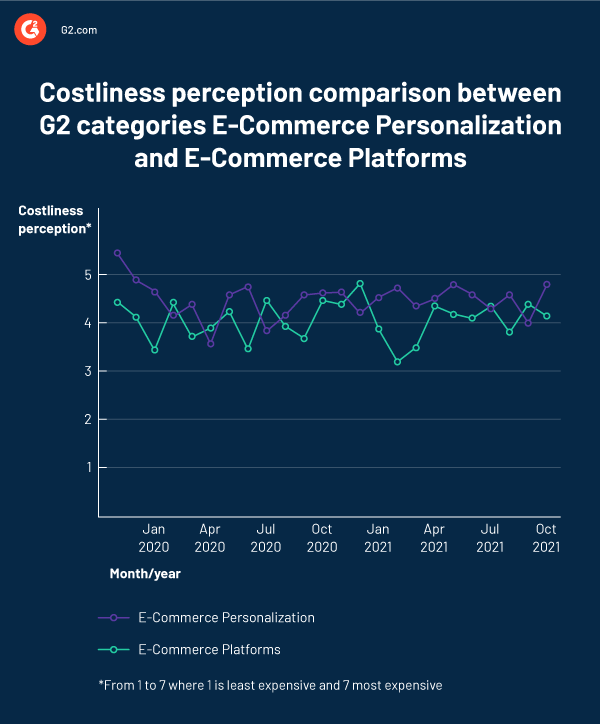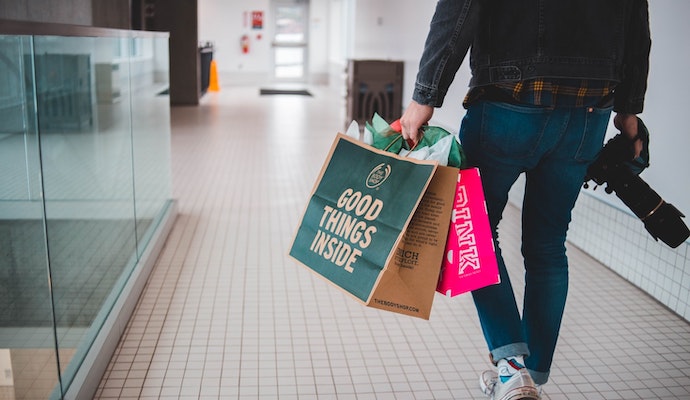This post is part of G2's 2022 digital trends series. Read more about G2’s perspective on digital transformation trends in an introduction from Tom Pringle, VP, market research, and additional coverage on trends identified by G2’s analysts.
The future of commerce in 2022
One may think that the future of commerce is predictable: almost all of us will shop online while most retail stores will close. While this may become a reality someday, short-term trends are more complicated and unpredictable.
There are now more ways to shop than ever, and buyer behavior is becoming more complex. As a result, manufacturers, suppliers, and retailers have difficulty keeping up with market changes, impacting their activities and creating a negative buyer experience.
Let’s look at some of the significant trends shaping commerce in the near future.
E-commerce and in-store retail aren’t mutually exclusive
2022 TRENDS PREDICTION
Hybrid shopping will require agile selling strategies that quickly adjust based on consumer demand and preferences.
E-commerce is booming, with an estimated growth of 50% globally between 2020 and 2024, but retail is far from being dead. In fact, 9 in 10 top e-commerce websites are managed by companies with brick-and-mortar stores. Therefore, it is not surprising that while the G2 E-Commerce Platforms category still has the highest traffic, its growth is much less significant than Retail POS and Multichannel Retail categories.
While the E-commerce Platforms category traffic was seven times higher than Retail POS and 17 times higher than Multichannel Retail in November 2019, it only grew approximately 2% in two years. The traffic for the other two categories more than doubled in the same period.
The dichotomy between in-store and online sales seems to be false. The two options not only can coexist but depend on each other. It may seem counterintuitive, but the COVID-19 pandemic accelerated the hybrid online and in-store shopping trend. As a result, new ways to buy are becoming more popular, such as subscriptions for products and services, pop-up stores, curbside pickup, self-checkout, and buy online and pick up in-store (BOPIS).
Also, more and more consumers prefer to rent instead of buying products from furniture to electronics and appliances, and even clothing. Finally, since repairing products is cheaper than buying new ones, the right to repair movement is gaining traction, which means that many consumers want to be able to repair a product instead of replacing it with a new one. Even Apple (that fought against right to repair laws), caved in to consumer pressure and recently announced a self-service repair program.
All these options require retailers and manufacturers to change their business models unprecedentedly.
Möchten Sie mehr über E-Commerce-Plattformen erfahren? Erkunden Sie E-Commerce-Plattformen Produkte.
It’s time for buyer experience initiatives to focus on the buyer
2022 TRENDS PREDICTION
Buyer experience initiatives will focus more on retention and less on new customers.
The explosion of e-commerce creates opportunities for most companies, but only those who can retain customers will win in the long term. Nowadays, consumers are switching brands at an unprecedented pace: 75% of US consumers tried a new shopping behavior, 96% in India, and 86% in China.
This means that personalization should expand beyond the sale and focus on the post-buying experience. The challenge with e-commerce personalization software is that it can be expensive and not always straightforward. Personalization features vary from basic cart abandonment pop-ups to sophisticated product recommendations using AI and machine learning.
While basic personalization software can be affordable or free, the overall user perception is that this type of software can be as expensive as e-commerce platforms. Ironically, e-commerce personalization software isn’t very customizable. G2 reviewers mentioned that they are having a hard time customizing templates for marketing campaigns and reports.

E-commerce personalization is perceived as being more expensive than e-commerce platforms by G2 reviews in the past two years.
At this point, personalization software focuses more on sales and less on loyalty, but there are more and more solutions that specialize in the post-sale experience. A few examples are software to manage returns and e-commerce specific customer service. In addition, these emerging software types will use and generate vast amounts of supply chain data, impacting supply chain visibility.
Supply chain disruptions will get worse before they get better
2022 TRENDS PREDICTION
Supply chain visibility will decrease in the near future, which will create a vicious cycle that will be difficult to break.
The e-commerce boom created opportunities for sellers and challenges for supply chain companies, primarily due to increased demand and global economic disruptions caused by the COVID-19 pandemic. As mentioned above, consumer behavior is getting more complicated and, therefore, more difficult to predict. Shoppers also seem to choose convenience over loyalty. For instance, US Consumers would rather switch brands than wait for out-of-stock products.
All these factors will have a negative impact on supply chain visibility. If retailers and manufacturers don’t have good visibility into their supply chain, consumers won’t get accurate information. Global supply chains are complex and have rigid mechanisms that weren’t designed to adapt to significant changes quickly. One recent change is the tendency to return to essentials (groceries and home supplies) and cut back on discretionary goods spending (apparel, cars, or furniture).
Combined with supply chain disruptions, significant changes in demand will make visibility even harder for both buyers and sellers.
What does all this mean for the future of commerce?
Commerce is similar to an enormous Jenga game with millions of pieces that can destabilize the entire structure when moved. As mentioned above, the significant movements nowadays are a shift in demand, labor changes (or the great resignation), and supply chain challenges that hurt shipping. As a result, buyer loyalty seems to be in a free fall, making it even more difficult for retailers to retain customers.
While new types of software like e-commerce personalization and omnichannel commerce will mature and artificial intelligence (AI) will play a more prominent role in commerce, I hope that consumers will adopt a more responsible buying behavior that should put less pressure on global supply chains.

Gabriel Gheorghiu
Gabriel’s background includes more than 15 years of experience in all aspects of business software selection and implementation. His research work has involved detailed functional analyses of software vendors from various areas such as ERP, CRM, and HCM. Gheorghiu holds a Bachelor of Arts in business administration from the Academy of Economic Studies in Bucharest (Romania), and a master's degree in territorial project management from Université Paris XII Val de Marne (France).
